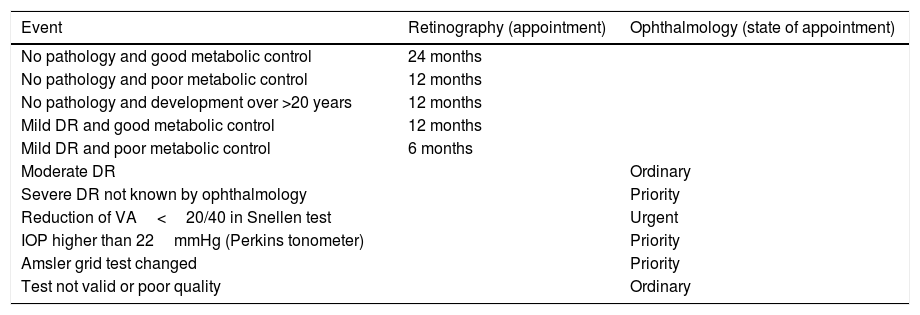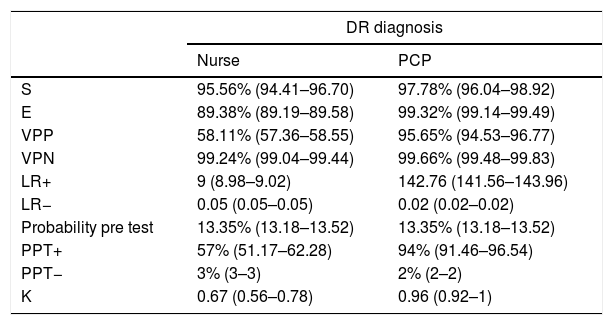To compare the evaluation of retinographies by a teleophthalmology nurse and primary care physicians (PCP) with an ophthalmologist referral hospital (gold standard).
MethodsCross-sectional study on a random sample of 337 patients on the teleophthalmology programme from January 2010 to January 2015. We analysed the diagnostic evaluation (whether or not it presented findings of RD) and the therapeutic assessment (whether or not referral to the opthalmology department was needed) which were conducted independently on the sample retinographies by the PCP, a nurse and an ophthalmologist (gold standard). Reliability and concordance between the gold standard and the PCP and the nurse were checked and the statistical analyses were supported using SPSSv.23.00 software and diagnostic test reliability calculators (EPIDAT 4.1).
ResultsIn the diagnosis of RD, the nurse presented: sensitivity (S): 0.96; specificity (Sp): 0.89; PPV: 0.58; NPV: 0.99; Kappa index: 0.67 and PCP: S: 0.98; Sp: 0.99; PPV: 0.96; NPV: 0.99; Kappa index: 0.96.
In the referral to ophthalmology assessed by the nurse: S: 0.83; Sp: 0.83; PPV: 0.51; NPV: 0.96; Kappa Index: 0.53 and PCP: S: 0.62; Sp: 0.76; PPV: 0.36; NPV: 0.90; Kappa index: 0.29.
ConclusionsA nursing teleophthalmology programme could perform population screening for RD with the same quality as PCP. This would increase coverage, in addition to providing better use of resources by avoiding intermediate patient appointments through PCP and increased health savings.
Comparar la evaluación de las retinografías para el cribado de retinopatía diabética (RD) realizadas por la enfermera de teleoftalmología y los médicos de atención primaria (MAP) con un oftalmólogo del hospital de referencia (estándar de oro).
MétodosEstudio transversal en una muestra aleatoria de 337 pacientes del programa de teleoftalmología desde enero de 2010 a enero de 2015. Analizamos la valoración diagnóstica (si presentaba hallazgos de RD o no) y la valoración terapéutica (si precisaba derivación al Servicio de Oftalmología o no) que realizaron de manera independiente sobre las retinografías de la muestra los MAP, una enfermera y un oftalmólogo (patrón de oro). Se comprobó la fiabilidad y concordancia de los MAP y la enfermera con el patrón de oro, apoyando los análisis estadísticos con SPSS v.23.00 y calculadoras de fiabilidad de pruebas diagnósticas (EPIDAT 4.1).
ResultadosEn el diagnóstico de RD, la enfermera presentó: sensibilidad (S): 0,96; especificidad (E): 0,89; VPP: 0,58; VPN: 0,99; índice Kappa: 0,67 y el MAP: S: 0,98; E: 0,99; VPP: 0,96; VPN: 0,99; índice Kappa: 0,96.
En la derivación a Oftalmología valorado por la enfermera: S: 0,83; E: 0,83; VPP: 0,51; VPN: 0,96; índice Kappa: 0,53 y el MAP: S: 0,62. E: 0,76; VPP: 0,36; VPN: 0,90; índice Kappa: 0,29.
ConclusionesLa enfermera del programa de teleoftalmología podría realizar el cribado poblacional de RD con la misma calidad que los MAP. Esto permitiría incrementar la cobertura, además de proporcionar un mejor aprovechamiento de los recursos al evitar citaciones intermedias de los pacientes a través del MAP y un mayor ahorro sanitario.








